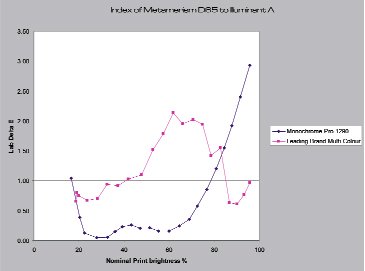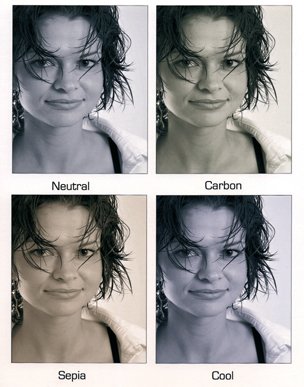articles/Monochrome/monomagic-page7
Monochrome Magic - part 7 of 1 2 3 4 5 6 7 8
Published 01/10/2004

Tone Variation across the range
Images vary from black to white with preferably as many tones as possible in between to achieve subtlety in this tonality. As we mentioned earlier, it is difficult to maintain the same base colour down the tone scale when using a 5,6 or 7 ink CMYK system unless the printer is bespoke profiled. Constant or gradually changing base tone down the scale is a measure of quality. Figure 2 shows the variation of base tone in a Monochrome Pro image. Note that the Permajet oyster paper has a cool blue base tone and that this is smoothly and progressively brought to a slightly cool neutral with the application of gradually increasing amounts of ink as the print tone darkens.

Monochrome pro is able to vary the tone over quite a wide range covering the traditionally available warm, cool and sepia tones loved by the silver halide monochrome specialists.
Metamerism
Coloured surfaces reflect and absorb light from different parts of the spectrum in different ways, that is the fundamental characteristic by which we see them as red or green or whatever colour we chose to describe them by. White light is a mix of the spectral colours and it is the variation in the mixtures that gives different types of light (e.g. fluorescent versus daylight) their different characters). Measurements of metamerism in prints look at the way that the different parts of the spectrum as reflected back to the eye. A grey can be made of a single pigment which reflects back equally over all parts of the spectrum. However the same perceived grey can be created by a varying mix of colours that create the same overall effect on the eyes. However this cosy system breaks down if the dyes are metameric and then the colour seems to change if different illuminating lights are used. The near perfect grey of a Kodak grey scale has a flat (INear) response when plotted on a graph. A grey created by a multi colour inkjet is more complex and the response curve is no longer flat but wanders up and down. The more it crosses the flat response line the more metameric is the colour. This is shown graphically in figure 3 for the mid tone (50% Lab lightness value - the so called 18% grey).
Please Note:
There is more than one page for this Article.
You are currently on page 7
- Monochrome Magic page 1
- Monochrome Magic page 2
- Monochrome Magic page 3
- Monochrome Magic page 4
- Monochrome Magic page 5
- Monochrome Magic page 6
- Monochrome Magic page 7
- Monochrome Magic page 8
1st Published 01/10/2004
last update 09/12/2022 14:56:49
More Monochrome Articles
There are 0 days to get ready for The Society of Photographers Convention and Trade Show at The Novotel London West, Hammersmith ...
which starts on Wednesday 15th January 2025





